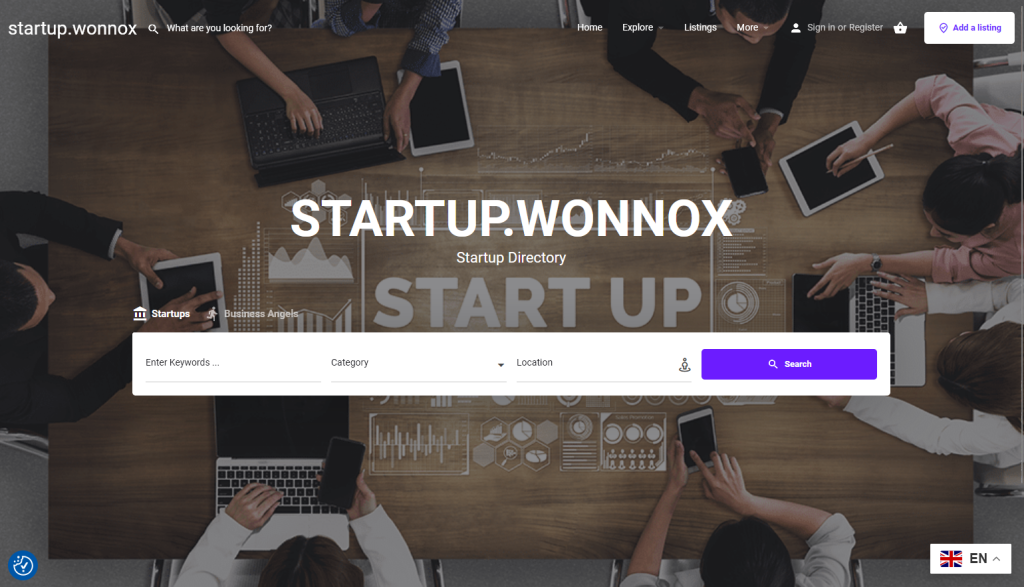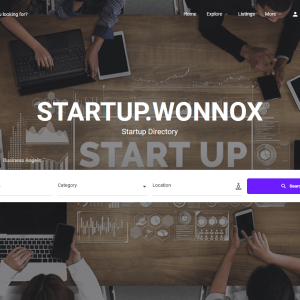
- Direct message
- Leave a review
- Bookmark
- Share
- Report
- prev
- next
Description
A business angel listing or profile in a web directory, especially under the "startup" category, is designed to showcase the background, investment interests, and value propositions that a business angel (angel investor) offers to startups. Business angels play a critical role in providing early-stage funding, mentorship, and strategic guidance to startups, often focusing on sectors they are passionate about or have expertise in. A detailed and well-crafted profile can attract promising startups looking for both financial support and strategic partnerships. Below are the key features of a business angel listing that can make it effective and appealing to startups:
1. Profile Overview:
Business Angel Name: The profile should prominently display the full name of the business angel, as this helps establish a personal connection and credibility.
Tagline: A short, catchy tagline that highlights the business angel’s core investment philosophy or focus areas, such as “Empowering Tech Innovators” or “Investing in Sustainable Startups.”
About Me: A brief introduction about the business angel, including their background, expertise, and the motivations behind their investment activities. This section often highlights their career achievements, why they became an investor, and their passion for nurturing startups.
2. Contact Information:
Direct Contact Details: Including a professional email address and/or a direct phone number for communication can facilitate easy inquiries from interested startups.
Social Media Links: Links to LinkedIn, Twitter, or any other professional social media accounts can help startups gain insights into the business angel’s activities, thoughts, and professional network.
Website URL: If the business angel has a personal website or blog where they share insights on investing or their experiences, it’s useful to include this link for additional information.
Location: Indicating the city and country of residence can be important, especially for startups that may be looking for local or regional investors who understand their market.
3. Investment Preferences:
Investment Stage: Clearly identifying the stages at which the business angel is interested in investing helps startups know if they are a suitable match. Common stages include:Pre-seed
Seed
Early-stage (Series A)
Investment Amount Range: Listing the typical investment range (e.g., $25,000 - $250,000) helps startups gauge whether their funding needs align with what the business angel can offer.
Preferred Sectors: Business angels often have specific industries they focus on, such as tech, healthcare, fintech, consumer goods, or clean energy. Highlighting these preferences makes it easier for startups in these sectors to identify relevant investors.
Geographic Focus: Indicating whether the business angel is open to investing in local, regional, or global startups helps filter potential matches. For instance, they might be focused on startups within the European Union or have a preference for emerging markets.
4. Investment Philosophy and Criteria:
Investment Philosophy: This section explains the business angel’s approach to investing. It might focus on their belief in supporting founders, promoting sustainability, or backing disruptive technologies.
Investment Criteria: Outlining specific criteria such as market potential, team strength, innovative technology, or scalability helps startups understand what the business angel looks for in an investment opportunity.
Stage of Involvement: This section can detail the level of involvement a business angel prefers in their investments, whether they take an active role as an advisor or board member, or prefer a hands-off approach.
5. Portfolio:
Past Investments: Listing previous investments provides a track record that builds credibility and helps startups see the kind of companies the business angel has supported. This may include:Startup Names: Displaying the names of startups the business angel has invested in, along with brief descriptions of each.
Investment Success Stories: Highlighting any notable successes or exits, such as acquisitions or IPOs, demonstrates the business angel’s ability to identify high-potential startups.
Industries Represented: Mentioning the various industries or niches the portfolio covers can further clarify the investor’s areas of expertise and interests.
6. Mentorship and Value-Added Support:
Advisory Role: Many business angels offer more than just financial support—they act as mentors and advisors to help startups navigate challenges. This section can detail the types of mentorship the business angel provides, such as:Strategic advice
Market entry strategies
Product development guidance
Fundraising support for later rounds
Network Access: A key value that business angels offer is access to their professional networks, which can include potential customers, partners, and follow-on investors. Highlighting this aspect can make the profile more appealing to startups looking for strategic connections.
Workshops and Training: If the business angel organizes or participates in workshops, boot camps, or training sessions for startups, this can be an attractive benefit for potential investees.
7. Testimonials and References:
Startup Testimonials: Including feedback from founders of startups the business angel has invested in helps build trust and credibility. These testimonials can highlight the value the business angel brought to their growth.
References: Providing references or endorsements from other investors, co-investors, or business partners can further validate the business angel’s reputation in the startup ecosystem.
8. Call to Action (CTA):
Engagement Prompts: A clear and compelling CTA encourages startups to reach out. Examples include:“Submit Your Pitch Deck”
“Request a Meeting”
“Reach Out for Investment Opportunities”
Submission Guidelines: If the business angel has specific guidelines for pitch submissions, such as what information to include in a pitch deck, they should be outlined here to streamline the process for startups.
9. Certifications, Affiliations, and Memberships:
Angel Groups and Networks: Mentioning membership in angel groups or investment networks, such as AngelList, Keiretsu Forum, or regional angel networks, adds credibility and shows a commitment to professional development.
Certifications or Investment Training: If the business angel has taken specialized training, such as angel investor courses or certifications, highlighting these can signal expertise and professionalism.
10. Investment Philosophy on Social Impact:
Socially Responsible Investing (SRI): If the business angel is particularly focused on startups that align with social or environmental impact, this should be highlighted. It can include focus areas like:Green tech or renewable energy
Social enterprises
Diversity and inclusion in startups
Impact Metrics: Outlining specific metrics or impact goals the business angel is interested in, such as reducing carbon footprints or creating job opportunities, can attract startups with aligned missions.
11. Events and Speaking Engagements:
Participation in Industry Events: Mentioning participation in startup pitch events, industry panels, or as a speaker at entrepreneurship conferences helps showcase the business angel’s active role in the startup ecosystem.
Organized Meetups or Webinars: If the business angel organizes meetups or webinars for startups, including these details can attract startup founders who are eager to learn and connect with investors.
12. Success Metrics and Achievements:
Number of Investments Made: Providing the total number of investments or startups supported can indicate the level of experience.
Exit Rate or Return on Investment (ROI): If applicable, mentioning statistics like successful exits or average ROI from investments can demonstrate the business angel’s track record in identifying and nurturing successful ventures.
Media Coverage: Featuring links to interviews or articles where the business angel has been featured can add to their credibility and authority in the field.
13. SEO and Keyword Optimization:
Keyword Integration: Including relevant keywords such as “seed stage investment,” “tech startup angel investor,” or “early-stage venture support” ensures that the profile is easily discoverable in the web directory.
Tags and Categories: Properly categorizing the listing under tags like “tech investor,” “green investment,” or “AI startups” helps match it with relevant startups.
14. Visual Elements:
Profile Picture: A professional headshot can make the listing more personal and approachable.
Videos: A short video introduction or an interview clip where the business angel talks about their investment philosophy can provide a more engaging overview.
Infographics: Visuals that show the business angel’s investment focus, portfolio distribution, or market trends can help convey key information quickly.
These features collectively ensure that a business angel listing is comprehensive, professional, and targeted towards attracting promising startups. A well-crafted profile can convey the business angel’s experience, investment philosophy, and the added value they bring beyond capital. By providing detailed information about their background, investment preferences, and the kind of support they offer, business angels can position themselves as valuable partners for startups looking to accelerate their growth.

Add a review